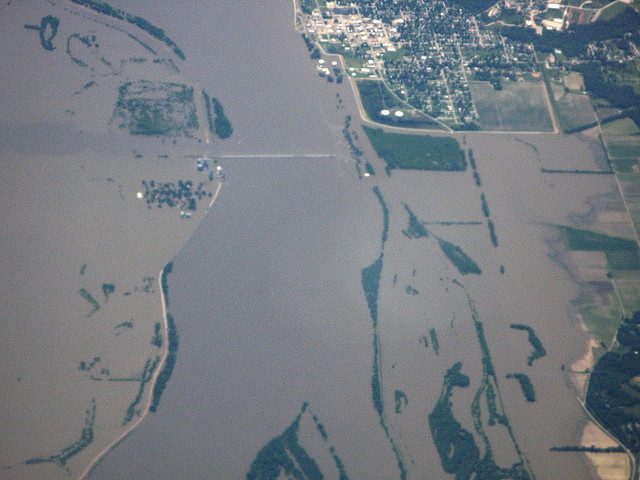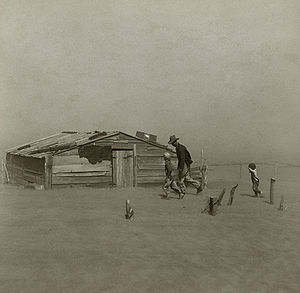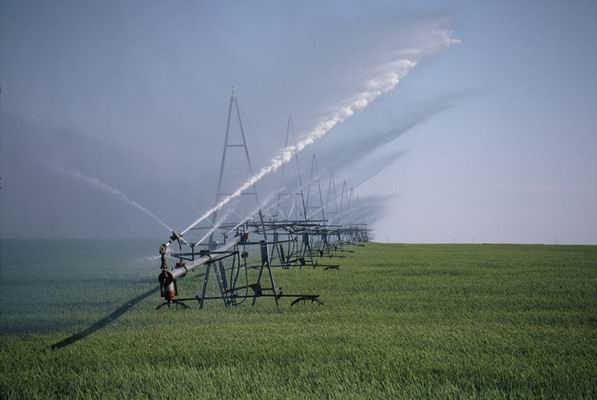Precipitation
Models indicate that precipitation will increase in high latitudes including places such as Northern Europe and Canada, but decrease in most subtropical land regions, including the southern tier of states from Texas to California. Droughts will become longer and more intense in these areas. A decrease in precipitation can reduce soil moisture over the short term and increase soil erosion rates over the long term. Likewise, as we have seen, the intensity of extreme events such as cyclones and hurricanes is likely to increase, also leading to potentially more significant crop damage, and also potentially, soil erosion. Waterlogged soils can cause severe damage to root systems and limit the uptake of nutrients. Flooding can cause permanent loss of many crops. One of the most significant periods of flooding in the US took place in the Midwest in 1993 when the Mississippi and Missouri rivers flooded their banks and submerged huge areas of farmland, a total of nine million acres. The estimated crop losses during this event were $7 billion. In the 2008 Midwest floods, Iowa alone lost $4 billion in damaged crops.

Precipitation may be crucial for determining the impact of climate on crops. Decreases in precipitation and evaporation-precipitation ratios in marginal areas that are currently entirely fed by rain may change ecosystem function to the point where irrigation is required. Estimates suggest that impact of increased evaporation will require increased irrigation requirements of 5-8% globally with higher amounts (15%) in Southeast Asia.
A key variable controlled by a combination of heat stress and rainfall is the 120-day growing period, the minimum duration required for crops such as corn to survive. Climate change has the potential to shrink the 120-day growing period, and this will greatly impact the sustainability of crop production.
Drought can be devastating to agriculture. During the decade-long “Federation” drought in Australia, from 1901-1903, an estimated 52 million sheep perished. In the long Dustbowl of the 1930s, over 75% of topsoil was lost in areas of Kansas, Oklahoma, and Texas, and crops were ruined. In fact, in many areas, agriculture never recovered from the drought, and the economic losses and human suffering are still legendary.

The following videos describe recent droughts in Texas and Australia:
Video: Texas-sized drought for Lone Star state (2:26)
CHRIS: In the South, it's not just the heat. It's the drought, which stretches from Florida all the way to Texas. CBS News correspondent Don Teague is in West Texas with more for us this morning. Don, good morning.
[COWS MOOING]
DON TEAGUE: Good morning, Chris. Texas is now in its third-worst drought in history for this time of year. Most of this state is 10 to 20 inches below normal rainfall totals. And that's hitting the cattle industry here and farmers hard.
DON TEAGUE: Third-generation farmer Henry Polansky has worked the land just north of Waco, Texas, for all of his 63 years.
HENRY POLANSKY: The crops are really hurting right now.
DON TEAGUE: He's seen droughts come and go.
HENRY POLANSKY: We rely so much on the weather.
DON TEAGUE: But the dry spell that's gripping Texas this year could prove disastrous.
DON TEAGUE: It's low here. And this corn should be over our heads?
HENRY POLANSKY: Oh, yes.
DON TEAGUE: His 520 acres of corn is struggling to grow at all.
HENRY POLANSKY: And this is all blight. It's not even going to make any seed here.
DON TEAGUE: At best, he figures his withering corn fields will only produce half of what they should this year, and that's if it rains soon.
HENRY POLANSKY: The rain will still help. But if we don't get any rain, like I said, in another couple of weeks, it's going to be over with.
DON TEAGUE: Already the drought in Texas has cost farmers and ranchers more than $1.5 billion. Neighboring states from New Mexico to Louisiana are almost as dry. And in New Orleans, thousands of trees planted in the aftermath of Hurricane Katrina are at risk of dying from lack of water. But Texas is by far the worst with 92% of the states suffering severe drought conditions.
[COWS MOOING]
DON TEAGUE: Cattle ranchers are selling off their herds because there's not enough grass to feed them.
DAVID HORNIK, CATTLE RANCH HAND: It's not going to last long before everybody has to cut down real bad or even sell out completely.
DON TEAGUE: Even horses can barely find enough to graze on. And Henry Polansky, along with millions of Texans, is hoping, even praying for rain.
[COWS MOOING]
DON TEAGUE: Well, these cattle here will all be auctioned off later today, most because of this ongoing drought. The temperatures have been scorching here as well. We've already had several 100-degree days in this part of Texas. Forecasters say no rain expected here any time soon. Chris?
CHRIS: Not the news they're looking for. CBS's Don Teague in West Texas for us this morning. Don, thanks.
Video: Extreme Drought in Australia - BBC Science (2:42)
[MUSIC AND HELICOPTER SOUNDS]
NARRATOR: Three hours away by plane from Sydney Harbor, and a world away from the boats and waterfronts, farming communities like Bourke are living at the sharp end of global warming.
[MUSIC]
NEWS ANCHOR: Now to 2WEB's weather forecast for Bourke, New South Wales. To all our farmers listening-- unfortunately, there is no rain in the forecast this week. Six years without significant rain. Times must be tough, but hang in there. Rain has to come soon.
NARRATOR: The Thompsons have been farmers for generations. They have 2000 acres of cotton that relies on water to grow. Unfortunately, they have been stuck in the worst drought in living memory and haven't been able to grow anything for six years.
MR. THOMPSON: Normally, this time of year, the crop would be up about two feet high, just almost starting to be a solid mass of green. You know, it's almost to the stage where you'd start to struggle to see up and down the rows.
[MUSIC]
NARRATOR: And the situation gets worse when you get down the river.
FARMER: Well, we're in the bed of the mighty Darling River, which is the longest river system in Australia. As you can see, it's bone dry. To my left here is our river pumps, which is what we use to extract water out of this river for irrigation.
NARRATOR: Only 14 months ago, this arid field was a lake. The Thompsons remember the good times playing in the water.
MRS. THOMPSON: We've got a jet ski. And the kids all can ski-- and wakeboards and kneeboards. It's really good when there's water here. You get sick of seeing the dirt and the dust, and the beautiful blue skies.
MR. THOMPSON: The worst case scenario is that the drought continues on for a couple of years and the equity that we have in our farm diminishes back to not much, or to nothing, then. I guess it's a forced sale. Ugh, I'd be devastated. Yeah, I'd be totally devastated.
We started with nothing when we came here.
[DEFEATED LAUGH]
[SOBBING]
MR. THOMPSON: To have a drought that's now, I think, classified as a one in 200-year drought sort of makes me think that there's probably something else going on. And I guess the issue of global warming probably has some merit.

